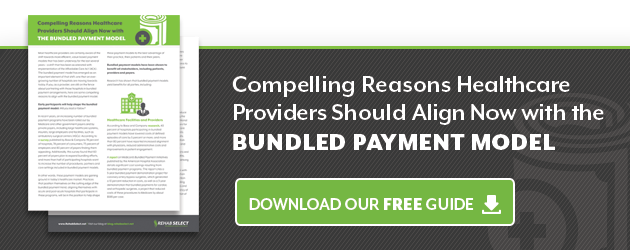 The bundled payment model is on the leading edge of the trend towards value-based healthcare, as evidenced by the increase in new bundled payment programs being implemented in today's healthcare marketplace. The goal of payment bundling is to reduce healthcare costs without compromising quality of care. Since this alternative to the traditional fee-for-service payment model is relatively new, there are still questions in the minds of many as to whether it works as well in the real world as it does on paper. So what do we know about the dollars and cents of the bundled payment model?
The bundled payment model is on the leading edge of the trend towards value-based healthcare, as evidenced by the increase in new bundled payment programs being implemented in today's healthcare marketplace. The goal of payment bundling is to reduce healthcare costs without compromising quality of care. Since this alternative to the traditional fee-for-service payment model is relatively new, there are still questions in the minds of many as to whether it works as well in the real world as it does on paper. So what do we know about the dollars and cents of the bundled payment model?
Given that bundled payments are a fairly new payment model, wide-ranging studies on their effects on healthcare costs are not, as of yet, available. However, a number of smaller-scale studies are, and they can offer some insight into whether or not the bundled payment model works to contain healthcare costs.
For example, a year-long pilot program implemented by CaroMont Health and Blue Cross and Blue Shield of North Carolina bundled payments for total knee replacement procedures. The defined episode of care covered by this bundled payment arrangement included a pre-surgical period of 30 days, the surgery and most follow-up care during a 180-day period after hospital discharge. Information gathered during the pilot showed a savings of about 8 to 10 percent per episode of care, as compared to the average cost per episode.
Medicare has also initiated a number of pilot programs using the bundled payment model that have shown promise in increasing the cost-efficiency of care delivered to Medicare beneficiaries. One demonstration, launched in 1991, bundled payments for coronary artery bypass graft (CABG) surgeries, with a defined episode of care that included all hospital and physician charges during hospitalization and any hospital readmissions within 90 days. Over 5 years, the program's seven participating hospitals were able to achieve savings for Medicare of about 10 percent, or $42.3 million, along with reduced rates of major complications and lower death rates.
Medicare's Acute Care Episode (ACE) demonstration tested bundled payment for cardiac and orthopedic surgeries over a period of three years. Defined episodes of care included hospital care and physician services during hospitalization. The five hospitals selected to participate in this program generated savings for Medicare of about $585 per episode. Participants' estimated savings were between $600 and $2,600 per orthopedic episode and ranged from $500 to $1,400 per cardiac episode.
The Bundled Payment for Care Improvement (BPCI) initiative, another Medicare pilot program, has also generated positive results, particularly in relation to certain orthopedic surgery bundles. The experience of one participating hospital provides a good example of the potential of this program. Euclid Hospital, a Cleveland Clinic Hospital, participated in BPCI bundles for total joint replacement of the lower extremity under Model 2 of the initiative. Shared savings generated over the hospital's first year of participation, across 271 episodes of care, totaled $522,389, or 9.8 percent, with $159,571 of that total savings going to Medicare and the remaining $362,818 awarded to the hospital. Significant improvements in quality and outcome measures were also noted over that same period of time.
What these examples demonstrate is that the participation in the bundled payment model does have the potential to deliver good results for providers and payers in terms of dollars and cents, as well as for patients in the form of high-quality, efficient healthcare. However, it is important to note that there is a learning curve involved in the bundled payment model, and initial mileage may vary from one provider to another based upon their level of preparation for this new payment model.





